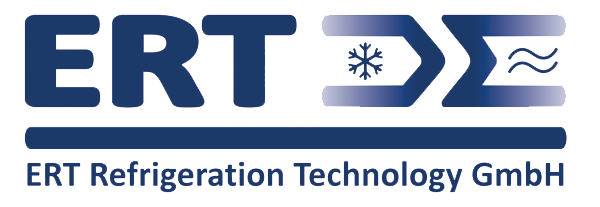Startseite > Operating principle
Functional principle | Absorption
How absorption works
Absorption in refrigeration describes the ability of certain liquids to absorb gases.
Absorption systems work with a gaseous refrigerant. In the absorber unit, the refrigerant gas is dissolved in water. This releases some heat (exothermic process), which is cooled away with cooling water so that the absorber unit continues to work efficiently.
If the refrigerant gas is dissolved in the water, it is practically no longer compressible and can be pumped to the higher pressure level of the refrigeration system with low energy input. As soon as the water/refrigerant mixture is at this pressure level, it is preheated in the solution heat exchanger and then subjected to the actual drive energy in the form of waste heat in the ejector. The refrigerant begins to dissolve from the water as it heats up. In the rectification column, the mixture is distilled several times and the refrigerant is completely separated from the water. The pure refrigerant vapour leaves the pressure port in the direction of the condenser.
From this point on, the system again corresponds to a conventional refrigeration system. The refrigerant is liquefied, subcooled and expanded to the evaporation pressure by an expansion element. In the evaporator, it absorbs the heat to be dissipated from the refrigerant and evaporates. Now the circuit closes and the refrigerant flows back to the absorber, which practically “sucks in” the gas instead of a conventional mechanical compressor. Here the refrigerant vapour is again absorbed by the water.
5 internal process steps for the use of waste heat as refrigerant
In the absorber unit, the refrigerant gas is dissolved in water. This releases some heat (exothermic process), which is cooled away with cooling water so that the absorber unit continues to work efficiently.
Due to its compression resistance, the refrigerant can now be transported to the higher pressure level of the refrigeration system.
The refrigerant is then preheated in the solution heat exchanger and pressurized. It begins to separate from the water as a result of heating.
In the rectification sun, the refrigerant mixture is distilled several times and completely separated from the water. The pure refrigerant vapour leaves the pressure port in the direction of the condenser.
From this point on, the system again corresponds to a conventional refrigeration system. The refrigerant is liquefied, subcooled and expanded to the evaporation pressure by an expansion element. In the evaporator, it absorbs the heat to be dissipated from the refrigerant and evaporates. Now the circuit closes and the refrigerant flows back to the absorber, which practically “sucks in” the gas instead of a conventional mechanical compressor. Here the refrigerant vapour is again absorbed by the water.
We are looking forward to your project!
Please contact us for a personal consultation. As soon as we have determined all conditions with you, we will work out an individual procedure for the best possible and most efficient project handling.
Call us: 49 40 7610 480


